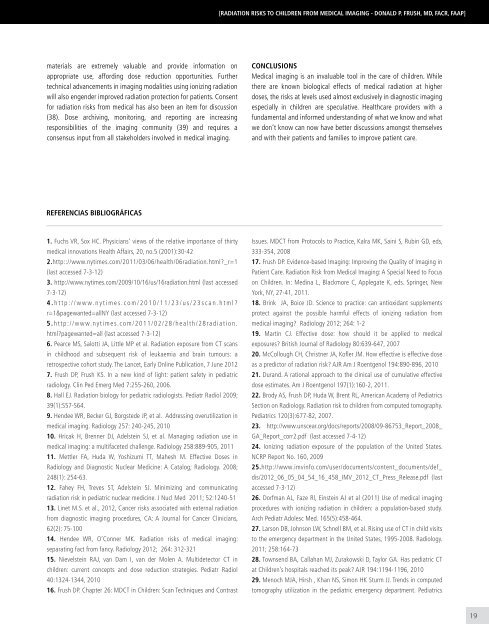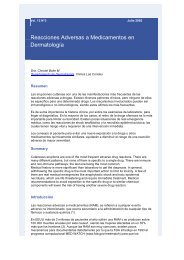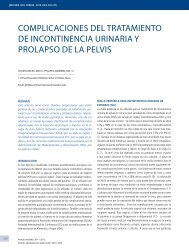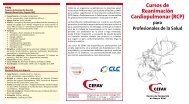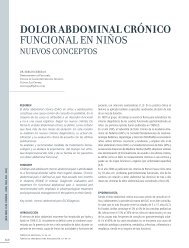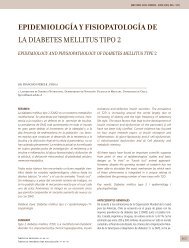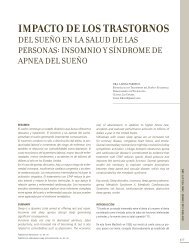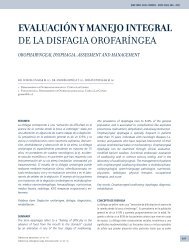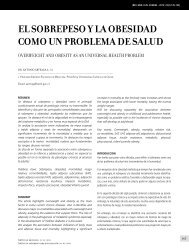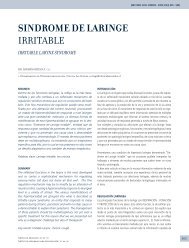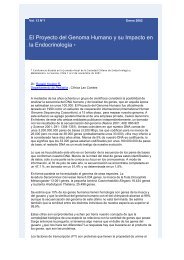ClÃnica Las Condes / vol. 24 n0 1 / enero 2013
ClÃnica Las Condes / vol. 24 n0 1 / enero 2013
ClÃnica Las Condes / vol. 24 n0 1 / enero 2013
You also want an ePaper? Increase the reach of your titles
YUMPU automatically turns print PDFs into web optimized ePapers that Google loves.
[Radiation Risks to Children from Medical Imaging - Donald P. Frush, MD, FACR, FAAP]materials are extremely valuable and provide information onappropriate use, affording dose reduction opportunities. Furthertechnical advancements in imaging modalities using ionizing radiationwill also engender improved radiation protection for patients. Consentfor radiation risks from medical has also been an item for discussion(38). Dose archiving, monitoring, and reporting are increasingresponsibilities of the imaging community (39) and requires aconsensus input from all stakeholders in<strong>vol</strong>ved in medical imaging.CONCLUSIONSMedical imaging is an invaluable tool in the care of children. Whilethere are known biological effects of medical radiation at higherdoses, the risks at levels used almost exclusively in diagnostic imagingespecially in children are speculative. Healthcare providers with afundamental and informed understanding of what we know and whatwe don’t know can now have better discussions amongst themselvesand with their patients and families to improve patient care.REFERENCIAS BIBLIOGRáFICAS1. Fuchs VR, Sox HC. Physicians’ views of the relative importance of thirtymedical innovations Health Affairs, 20, no.5 (2001):30-422.http:://www.nytimes.com/2011/03/06/health/06radiation.html?_r=1(last accessed 7-3-12)3. http://www.nytimes.com/2009/10/16/us/16radiation.html (last accessed7-3-12)4.http://www.nytimes.com/2010/11/23/us/23scan.html?r=1&pagewanted=allNY (last accessed 7-3-12)5.http://www.nytimes.com/2011/02/28/health/28radiation.html?pagewanted=all (last accessed 7-3-12)6. Pearce MS, Salotti JA, Little MP et al. Radiation exposure from CT scansin childhood and subsequent risk of leukaemia and brain tumours: aretrospective cohort study. The Lancet, Early Online Publication, 7 June 20127. Frush DP, Frush KS. In a new kind of light: patient safety in pediatricradiology. Clin Ped Emerg Med 7:255-260, 2006.8. Hall EJ. Radiation biology for pediatric radiologists. Pediatr Radiol 2009;39(1):S57-S64.9. Hendee WR, Becker GJ, Borgstede JP, et al. Addressing overutilization inmedical imaging. Radiology 257: <strong>24</strong>0-<strong>24</strong>5, 201010. Hricak H, Brenner DJ, Adelstein SJ, et al. Managing radiation use inmedical imaging: a multifaceted challenge. Radiology 258:889-905, 201111. Mettler FA, Huda W, Yoshizumi TT, Mahesh M. Effective Doses inRadiology and Diagnostic Nuclear Medicine: A Catalog; Radiology. 2008;<strong>24</strong>8(1): 254-63.12. Fahey FH, Treves ST, Adelstein SJ. Minimizing and communicatingradiation risk in pediatric nuclear medicine. J Nucl Med 2011; 52:1<strong>24</strong>0-5113. Linet M.S. et al., 2012, Cancer risks associated with external radiationfrom diagnostic imaging procedures, CA: A Journal for Cancer Clinicians,62(2): 75-10014. Hendee WR, O’Conner MK. Radiation risks of medical imaging:separating fact from fancy. Radiology 2012; 264: 312-32115. Nievelstein RAJ, van Dam I, van der Molen A. Multidetector CT inchildren: current concepts and dose reduction strategies. Pediatr Radiol40:13<strong>24</strong>-1344, 201016. Frush DP. Chapter 26: MDCT in Children: Scan Techniques and ContrastIssues. MDCT from Protocols to Practice, Kalra MK, Saini S, Rubin GD, eds,333-354, 200817. Frush DP. Evidence-based Imaging: Improving the Quality of Imaging inPatient Care. Radiation Risk from Medical Imaging: A Special Need to Focuson Children. In: Medina L, Blackmore C, Applegate K, eds. Springer, NewYork, NY, 27-41, 2011.18. Brink JA, Boice JD. Science to practice: can antioxidant supplementsprotect against the possible harmful effects of ionizing radiation frommedical imaging? Radiology 2012; 264: 1-219. Martin CJ. Effective dose: how should it be applied to medicalexposures? British Journal of Radiology 80:639-647, 200720. McCollough CH, Christner JA, Kofler JM. How effective is effective doseas a predictor of radiation risk? AJR Am J Roentgenol 194:890-896, 201021. Durand. A rational approach to the clinical use of cumulative effectivedose estimates. Am J Roentgenol 197(1):160-2, 2011.22. Brody AS, Frush DP, Huda W, Brent RL, American Academy of PediatricsSection on Radiology. Radiation risk to children from computed tomography.Pediatrics 120(3):677-82, 2007.23. http://www.unscear.org/docs/reports/2008/09-86753_Report_2008_GA_Report_corr2.pdf (last accessed 7-4-12)<strong>24</strong>. Ionizing radiation exposure of the population of the United States.NCRP Report No. 160, 200925.http://www.imvinfo.com/user/documents/content_documents/def_dis/2012_06_05_04_54_16_458_IMV_2012_CT_Press_Release.pdf (lastaccessed 7-3-12)26. Dorfman AL, Faze Rl, Einstein AJ et al (2011) Use of medical imagingprocedures with ionizing radiation in children: a population-based study.Arch Pediatr Adolesc Med. 165(5):458-464.27. Larson DB, Johnson LW, Schnell BM, et al. Rising use of CT in child visitsto the emergency department in the United States, 1995-2008. Radiology.2011; 258:164-7328. Townsend BA, Callahan MJ, Zurakowski D, Taylor GA. Has pediatric CTat Children’s hospitals reached its peak? AJR 194:1194-1196, 201029. Menoch MJA, Hirsh , Khan NS, Simon HK Sturm JJ. Trends in computedtomography utilization in the pediatric emergency department. Pediatrics19


